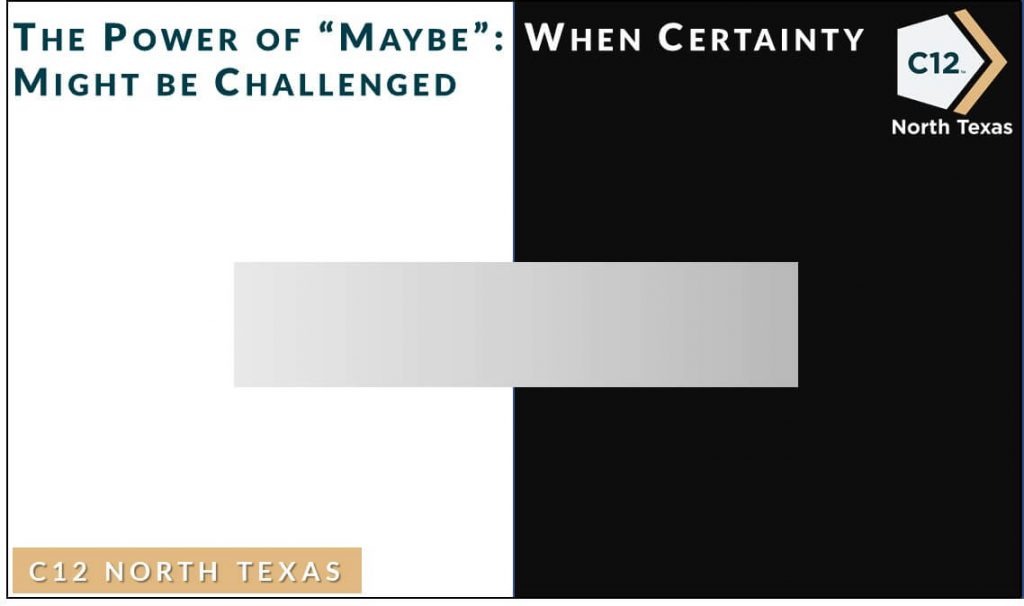Our Promise to
Every Member
We promise to be an example of all we promote, to be accountable to our members and to seek their correction when any deviations appear. We serve as a resource for education, encouragement, challenge, inspiration and accountability.
The Power of “Maybe”: When Certainty Might be Challenged

Certainty is a virtue, isn’t it?
Where would we be without confident, black and white answers to important questions? There is great comfort in knowing something to be true or in taking a position that does not need to be reexamined each day. So, we test our beliefs and fix them in our minds. Without such a process, life would be too incredibly complex. It is enough to deal with new things without having to question what we already know. Makes sense to you?
And yet, unyielding certainty in business can be a trap.
When my daughter was young, it was a regular event every few months for her to ask if she could have a dog. My answer was always the same, “No, Sweetie, a dog is a lot of responsibility and work.” She cheerfully and consistently accepted my short answer (which never varied) for years. Then she approached me one night while I was sitting on the couch with my son. “Daddy,” she said, “could I have a dog?” Well, the usual tape started running, “No, Sweetie, a dog is a lot of responsibility and work.” When I resumed talking with my son, I could see out of the corner of my eye that my daughter had not moved. Turning back toward her, I could also see that there were tears in her eyes. Off she ran upstairs. My son and I exchanged bewildered looks. “What was that all about?” he asked.
That night as I was putting my daughter to bed, I found her lying rigid on her back still affected by my answer. I asked her if she was upset at me. Without making eye contact, she nodded her head “yes.” Quietly, I said, “But, Sweetie, you know that I always say ‘no’ when you ask for a dog. A dog is a lot of responsibility and work.” (Perhaps if I whispered the words she would accept them better, I thought.)
Turning to look at me directly, she delivered to me an important lesson.
“Daddy, you could have said ‘maybe’.”
There is so much simplification that occurs in business. Much of that simplification is necessary because the competitive environment is simply too complex to rethink things very often. So, we analyze, categorize, and prioritize so that the few most critical issues are worked hardest. Over time, the people that are involved know and can repeat the common approaches to both the lower priority issues and those that are getting special attention. Indeed one measure of the success of process standards is the general awareness and execution of those very efforts. What’s the problem with all of this?
The first problem is that all answers (even good ones) have an expiration date.
Things are constantly changing. Thinking back on the high technology industry, for example, there are many things that were once givens but are no longer true. IBM’s mainframes are not the best, safe choice any longer. Yahoo does not dominate online search. PC software standards have been being supplanted by web-based applications. NBC, ABC, and CBS do not have the eyes and ears of American consumers all to themselves. Things happened and somewhere along the way, someone knew that change was coming and had an idea about how to capitalize on that change. The truth is that all business answers are temporary and predicting the timing of change is a critical skill for marketers and strategists.
The second problem is that all answers have dependencies.
In fact, the dependencies are often a richer source for understanding than the straightforward answer. It is an important lesson that assumptions and dependencies have to be documented. Owners and strategists often deal with questions and answers that are not perfectly defined. Answers are very important to them but the dependencies help illuminate the risk that is implicit in the directions that they choose.
Here are five ways to recognize that the common answers are stale in your organization.
1. Everyone knows the same answer. This may be counter-intuitive but it can signal that much time has passed since the original question was asked. Even simple answers take time to percolate through an organization and the fact that “everyone” knows and can state the answer with confidence may prompt an action to reexamine the original question.
2. Few can recall the original question. That is, many people may know the conclusion but they may be completely unaware of the context of and motivation for the first inquiry. This is a great danger sign because it drives actions and plans that may easily go awry. Context-free answers can lead to unintended consequences for a business. People have forgotten the “why.”
3. The answers bear little relationship to what is currently happening. Many times a company will trudge along with their version of the competitive truth but there is no recurring justification for that truth. Maybe the answer was useful and true three years ago but the critical competitive factors are different now. Clinging to a known answer when contrary evidence is available is dangerous.
4. No one can answer the “it depends on what” question. Every answer has dependencies that often are part of the original question. In healthy organizations, there is vigorous debate over the answer to the question with advocates representing all sides of the argument. Every side will illustrate their points with the assumptions and dependencies which matter most. Finally, one answer from among many possibilities will be selected. Now here’s the rub. The answer may be well remembered but the arguments are forgotten. This is a grievous loss for an organization. Over time what has been lost may exceed the value of the initial good answer.
5. The common answers motivate no useful actions. Occasionally some answers actually become museum pieces. They have a place in a strategy display case that employees can point to and admire. But, no one can link those answers to any important action. It is easy to see this is people by asking them to state what drives them each day. If the common actions are stale, their replies will quickly vector to something different. Usually, this will be some tactical situation that is independent of strategic answers.
My daughter reminded me that night to not give her canned, rote answers that did not acknowledge that she had grown up (things change too fast for a father). The next day she had her beautiful yellow Labrador puppy, Flash. (It wasn’t too long after that she had her second dog, Goldie, because, oh my, Flash was lonely.)
The beauty of “maybe” is that it helps us consider that important things may have changed.
“Maybe” makes it possible to have discussions again to challenge what we know and think about our business and the competitive environment. “Maybe” keeps us humble about complexity and open to learning important new things. “Maybe” leaves us open to considering the inputs, feelings, and priorities of others.
There is an excellent case for practicing “maybe” regularly.
We talk about things like this at our C12 Executive Roundtables each month. Peers question, challenge, and encourage one another to reject simplicity and comfort when a new approach is called for.

Tom Hawes is the Principal Chair for C12 North Texas. Since 2011, Tom has had the pleasure of facilitating forums in North Texas. Contact him at [email protected] or 214-620-9366.
Recent Blog
Archives
2020
-
September (1)
-
August (3)
-
July (1)
-
March (4)

